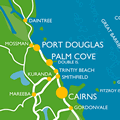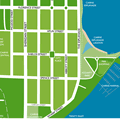Cairns
From OZCHI
Cairns
Cairns is located in Tropical North Queensland (TNQ) and is served by an International Airport (airport code CNS) which is a 15-minute drive past mangroves and cane fields to the conference location at James Cook University (JCU). Cairns is easily accessible for both international and local participants, with over 60 international flights per week, and domestic flights linking Cairns to all major Australian capital cities.
| Queensland Coast Map | Cairns Map | |
 |  |
Attractions
Tropical FNQ is the only place on the planet where two World Heritage listed areas, the Great Barrier Reef and the Wet Tropics, are side-by-side. The area is steeped in indigenous cultural heritage and there are a growing number of wonderful, indigenous-owned and guided tours. The climate in early December has a comfortable temperature ranging from 220C to 310C, offering 8.5 hours of sunshine, moderate rainfall and sea temperature of 270C. There is an extensive range of attractions suited for one day or two day trips including: Reef and Islands, Daintree and Cape Tribulation, Port Douglas resorts, the Cassowary Coast, the Tableland townships, Cooktown and Cape York Peninsula. Equally, there is a wide range of options within close proximity to the university for participants to relax during the conference for a couple of hours.

Pre and post conference tour packages
Participants may wish to combine attending the conference with leisure activities as the area, which draws over a million visitors each year, is well served by affordable accommodation, multi-lingual tourist services and a wide range of unique activities. Suggestions for pre and post conference tour packages
Conference venue: James Cook University
2008 will be the first time in four years that a regional university has hosted OZCHI. Thus, the location also offers the opportunity to reflect on interaction design contexts characterised by highly dispersed populations and rural, remote communities and opportunities beyond large urban research and development centres. This is compatible with the need for design to contribute to socio-economic sustainability in response to growth in mining and tourism sectors and the impacts of climate change and peak oil on agricultural industries and rural-to-urban commuting. JCU campus map

Tropical North Queensland
Tropical North Queensland encompasses 46% of the land mass of Australia, accounts for 28% of overseas merchandise exports and is home to 37% of Australia's Indigenous population. There is a continuing tendency in HCI to orient studies and design of technologies to 'white-collar', fully-abled urban-dwellers; we hope that holding the conference in a different locale will encourage participants to take the challenge of designing experiences and interactions "for all" seriously.
James Cook University campuses are distributed across several 1000 km2 of Tropical North Queensland. Such geographic spread reflects both the vital economic importance of the region to Queensland's economy and very low population density. Queensland in its entirety, including some 1,000 islands, covers 1,734,190 km2, which is equivalent to the entire British Isles and Western Europe together. Despite being Australia's second largest state and fastest growing population Queensland's population, at two people per km2, remains less than that of Sydney. Yet, Queensland's gross economic growth rate is twice that of Australia nationally and the state has the highest per person spending on infrastructure (totalling almost $4 billion in 2006-07). Queensland also has a burgeoning IT industry. As a result of its Smart State initiative Queensland is recognised as a global centre in biotechnology and health research and the State Government invests $60 per person on research, more than NSW ($44) and Victoria ($40). Expenditure by Queensland businesses on research and development (R&D) has recorded growth of 135% between 1999 and 2005 and knowledge-intensive merchandise exports grew at double the national rate between 1999 and 2005. Global companies such as Mincom, Groundprobe and Boeing are developing innovative, world leading technologies in Queensland and Queensland universities spend almost 60% of their total R&D expenditure on applied and experimental research, more than universities in any other state.
While very sparsely populated, the industries of Tropical North Queensland underpin the whole of Queensland's economic growth. Their lands and soils are essential resources that support mining, tourism and agriculture. Much of the $12.1 billion generated by mined commodities in 2003-04 in Queensland originated north of Capricorn. In 2004-05, 40% of international visitors to Australia came to the north, often to visit the Great Barrier Reef and Tropical rainforests close to Cairns. Around 87% of Queensland is used as grazing land, whilst protected areas cover 4% and forest and timber reserves a further 2.4%.
Tropical North Queensland is culturally diverse and like other parts of Queensland has one of the largest and most rapidly growing Aboriginal resident populations, at 146,400 in 2006. Within the state there is a marked difference in relative population distribution, for example, 24% of the Aboriginal population live in remote or very remote areas of Queensland compared with 4% of overall population and 23% of the Aboriginal people live in Outer Regional Queensland compared with 18% of the overall population.